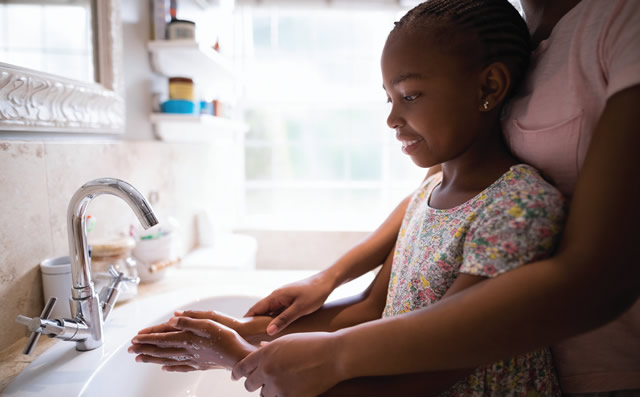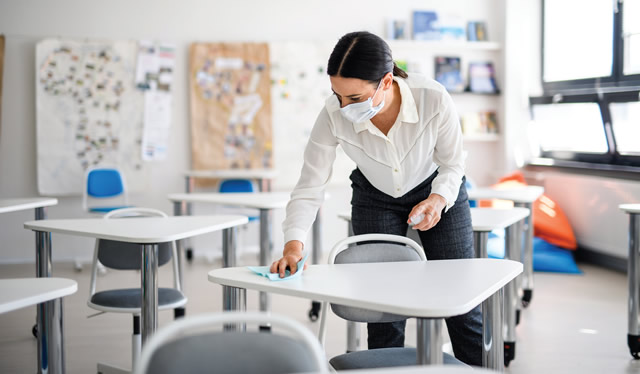It's Everyone's Role To Keep Our Schools Healthy, Safe and Open
Standard hygiene practices, like proper handwashing, are more important than ever.
After a year of hybrid and distance learning, many K-12
schools across the country are looking to return to “normal” by
holding in-person classes. Simple hygiene practices like proper
handwashing can have a major impact, reducing gastrointestinal
illness by 50% (Family Medicine) and absenteeism by up to
50% (American Journal of Infection Control).
With a potentially difficult flu season looming and
many school-aged children unable to be vaccinated against
COVID-19, it is critical for administrators and leaders within
the school community to understand all necessary hygiene
and cleaning protocols. Below are some key guidelines to focus
cleaning protocols and help faculty, students, their families and
faculty and staff stay healthy and in-school.

Importance of Hand Hygiene
Despite its simplicity, handwashing is an activity most people do
not do as often as they should. One study found 58% of female
and 48% of male middle- and high-school students washed their
hands after using the bathroom, and 33% of females and 8% of
males used soap (American Journal of Infection Control). Adults
aren’t off the hook, either. In fact, a study conducted by the American
Cleaning Institute with the American Society of Microbiology
reported 92% of adults claim to always wash their hands in
public bathrooms, but only 77% were observed doing so.
Keeping clean through good hand hygiene is one of the most
important steps everyone can take to avoid getting sick and
spreading germs to others. That means regularly washing hands
with soap and water or using alcohol-based hand sanitizer with
at least 60% alcohol when soap and water are not available. By
teaching proper hand hygiene to children at home and at school
— and setting a good example by washing your hands (the right
way) throughout the day — school faculty and administrators
have the power to decrease the spread of illness-causing germs.
Remember, proper hand hygiene includes:
- Wetting your hands with running water, then turning the
tap off
- Lathering hands with soap and scrubbing the front and backs
of your hands and between fingers for at least 20 seconds
- Thoroughly rinsing hands
- Drying hands with a clean towel or air drier
Hands should always be washed:
- After using the bathroom
- Before and after eating a meal
- After coughing or sneezing
- After returning from school
Administrators and Educators
Sick days are expensive! Between extra time teachers spend
catching students up, lost workdays for parents and paying for
substitute teachers, sick days cost the U.S. approximately $120
billion each year (CDC). Through promoting hand hygiene and
instilling proper cleaning and disinfecting practices throughout
the entire school community (which has the potential to extend
to the home), administrators can help ensure better health and
education outcomes.
As administrators lead their school communities, be sure to
set the example for staff and students by washing your hands
regularly and providing the necessary supplies to help students
and staff keep clean and safe. Work with school nurses and custodial
staff to ensure facilities are
prepared for the return of students
with the correct amount of
supplies including hand sanitizer,
soap, disinfectants and other
cleaning supplies.
Teachers and staff who are
pressed for time and are taking
on additional cleaning responsibilities
throughout the school day can help streamline the
cleaning process by disinfecting frequently-touched surfaces
like tables, keyboards, sink faucets and shared supplies. As part
of teaching proper hand hygiene, teachers should give students
time to wash hands at key moments throughout the day, like after
using the bathroom, going to lunch and returning from recess.
Other classroom cleaning tips include minimizing shared
supplies, decreasing clutter and keeping sanitizer with at least
60% alcohol easily accessible — though supervised — for times
when hand washing isn’t possible.
As teachers are called on to clean more than usual, remember
to never mix cleaning products and to always read the label
and follow directions prior to cleaning and disinfecting. Where
possible, open doors and windows to ensure adequate ventilation,
and store all disinfectants out of reach of students.
School Nurses
School nurses can make a critical difference in preventing
the spread of infectious diseases in schools. In the U.S. today,
only 39.3% of schools employ full-time school nurses and 1
in 4 schools does not employ a school nurse, making a nurse’s
time and expertise even more valuable (National Association
of School Nurses). We encourage school nurses to develop an
action plan, engage students and get the school community involved.
To create a culture of clean in a school, nurses can help
get facilities ready for the return
of students by ensuring hand
sanitizer dispensers are in place
and reinforcing proper hand hygiene
by placing reminders and
informational posters in classrooms
and near bathroom sinks.
As an authority figure, set the
example by teaching students
how to reduce the spread of germs and practicing proper hand
hygiene at all times.

Parents
All learning and healthy habits truly begin in the home. At ACI,
we know how fun and yet how difficult it can be to teach young
children how to stay clean and healthy. Teach them proper handwashing
techniques, how to cover their mouths when coughing
or sneezing and to not share drinks or food items with other kids.
Show them how to stop the spread of germs by letting them
watch you wash your hands and keep the house clean.
As your kids return to school, consider introducing
some new practices to your after-school routine:
- Leave backpacks, shoes and outerwear near the door.
- Wash hands when kids get home from school.
- Wash and dry face masks where applicable.
- Stay alert, monitor children’s health and keep them home if
they are sick.
By continuing to reinforce good hygiene habits at home, you will
help protect the health of your family, school and community.
We All Play a Role
When It Comes to Health and Safety
We are all responsible in helping decrease the spread of germs and reduce
illness. All members of the school community should set good
examples for handwashing and cleaning throughout the school year.
At the American Cleaning Institute, we want to do our part
to keep educators, parents and children safe as they return to
school. That’s why we’ve teamed up with the Centers for Disease
Control and Prevention (CDC) to launch the Healthy Schools
Healthy People initiative to help reinforce hand hygiene and
cleaning practices to prevent the spread of infectious disease and
reduce related absenteeism.
The new, interactive site offers resources for all members of
the school community, including children, and provides additional
guidance on proper cleaning, disinfecting and hygiene
guidance from downloadable resources, expert-led webinars and
more. With proper cleaning and healthy habits, we can prepare
school facilities to keep students clean and healthy year-round.
This article originally appeared in the Fall 2021 issue of Spaces4Learning.